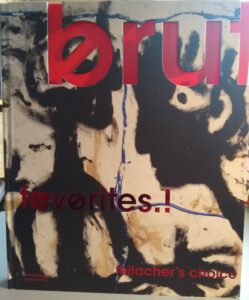Published 2022 by Residenz Verlag; ISBN 978-3-7017-3577-8. Edited by  Johann Feilacher
Johann Feilacher
Preface, by Johann Feilacher, translated by Alexandra Cox
brut favorites? Or what we saying, here—“raw favorites”? “Brut” gets used for quite a number of things these days, much is “brut”: Music, people, an exhibition… This description, “brut”, is virtually overblown now, but I am using it as a title, nevertheless. This time, it is in the sense of “emotional”, “raw”, “uncontrolled”, or “consciously overstepping conventions”.
On this occasion, in my final publication for museum gugging, Art Brut is not that alone: that would be not be commodious enough to allude to a final exhibition under my curatorship in this establishment. What else, though, is “brut” intended to be in this context? Well, there certainly is such a thing as “raw” art, uncooked art, outside of Art Brut. The kind of art that is created “randomly” and casually, that simply comes from inside. There is no cookbook on the subject for getting ideas—no, it should be something entirely of its own. Uncontrolled and unbeautified, so that it fits the definition of “primal”.
You could say being “brut” simply meant “going hog wild” (or at least a little bit crazy). That would be good—we would all love to do that. But when not many manage it, perhaps contemplating such creations could be a substitute. So: “brut”, after all. And for as many recipients as possible.
And “favorites”? —Those are things that we like. And they can be multifarious things. There is no clashing, though—just completion. Life is complex: why shouldn’t art be, too? And with art, its enthusiasts as well, the “recipients”, the consumers, the gourmets of the arts and some who surround themselves with such things, some even until they are “fit to burst”. Yet they keep on going! Art forms are amassed like you wouldn’t believe. Identical or laden with contrasts and contradictions.
The elixir of life, which people apparently even go to war for, as Churchillian legend tells it. So let’s have as many “brut favorites” as possible.
Many years of working in this profession leave their mark, on one’s self and on other people and institutions. Sixteen years at museum gugging have given many of my favorites the chance to get put on show in Gugging. Many thousands of artworks, as dry and unsweetened as Champagne, therefore “brut”; for instance, those by the Gugging Artists, but also others, produced in contrasting ways, that were created to specific, controlled ends. Thangkas of Tibetan monks, for instance, or war shields, objects of the highland Papuas animated by the energy of forebears. Gugging, during this time, was itself animated by the opinion that art is meant to be exhibited in a museum under exactly as many contrasts as are carried by life itself.
In actual fact, I have always exhibited (my) favorites, be they unique objects by Gaston Chaissac, the sculptures of Judith Scott, or drawings by Johann Hauser, August Walla, Philipp Schöpke, Johann Korec, and a number of other Gugging Artists. Works by the self-described autodidact Sava Sekulić, the hyperrealist Adria Sartore (quite a contrast), the litterateur (and draftsman) Adolf Wölfli, pictures of love by Aloïse Corbaz, and flying objects by Jürgen Tauscher.
This exhibition, therefore, is intended to highlight those artists and works that have found little space in museum gugging up to now, but which, actually, always should have been put on show: finger-paintings by Louis Soutter, a fixed star in the art firmament; the earthy, simple paintings of Mary T. Smith; drawings by Franz Gableck. It is impossible to show even more primal works than the ones from the actual Stone Age, since cave drawings cannot be brought into the museum, but cultural Stone Age prevailed into the 1930s in the highlands of New Guinea, where artists were active whose works can be presented here.
And yet another apparent contrast to high culture: contingencies that do not exist—at least not in psychology or criminalistics. Artifacts, “scraps” created by-the-by, always point (one way or another) to their creators. Draftspeople’s underlays are scribbled on, heaps of paint accrue on palettes, templates and stencils are used. In specific circumstances, the 20th century learned to receive even these objects as “art”, if they closely resemble deliberately created works or are even their equivalents. That is a likewise very exciting field of aesthetics that would not have garnered recognition before the 20th century. Look forward, then, to a presentation of “favorite” contrasts.
